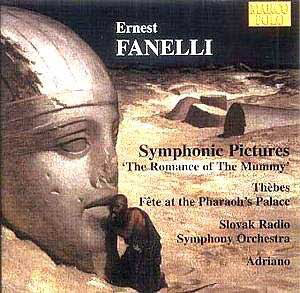The conductor Adriano has built up a fine reputation
for discovering (or re-discovering) opulent and colourful Late Romantic
music and for his well-received Marco Polo film music albums - particularly
those devoted to Georges Auric. This new release of music by the forgotten
French composer Ernest Fanelli, whose patron was Pierné, would
seem to straddle both genres. Not only does this effulgent material
anticipate Respighi, Richard Strauss and Debussy (to mention just three
composers) but it also points the way to the film music of the mid-20th
Century - particularly that of Bernard Herrmann. Fanelli was regarded
by many as too avant-garde. Listen to this music composed in 1883/6
(although not premiered until 1912, just one year before Stravinsky's
Sacre du Printemps) and you will immediately hear why. As Adriano
comments in his learned booklet notes:
"Already in 1883 Fanelli uses whole-tone scales, intervals
of a ninth and picturesque harmonic and instrumental effects which later
became trademarks of the Impressionists. Polytonality, uneven metres,
unmodulated changes of harmonies, free ornamentation, the use of augmented
triads and an overall non-relation to basic tonality can be found in
Tableaux Symphoniques, perhaps the first example in French music history
in which sound and instrumental colour become principal means of musical
expression and in which a composer dares to transpose his purely sensorial
impressions and detaches himself from absolute music and traditional
romantic tone-painting."
Fanelli's Tableaux symphoniques d'après ‘Le
Roman de la Momi’, to give the work its proper French name, is presented
here in two parts each with three movements. Briefly it concerns the
fate of Tahoser an Egyptian girl who has fallen in love with Poëri
a handsome young Hebrew. Ramses II the mighty Pharaoh is attracted to
her too and resolves to have her at all costs. When Tahoser discovers
that Poëri is in love with another woman, she languishes and becomes
ill. She is healed by the mysterious prophet Moses who initiates her
into the cult of Jehovah. Ramses manages to abduct Tahoser and becomes
an enemy of the Jews leading to the oft-told events of the plagues,
the exile and the parting of the Red Sea. Tahoser is crowned Queen of
Egypt and discovered in Pharaoh's tomb by a 19th century archaeologist
who falls in love with her mummy.
Part I entitled Thèbes is in three movements
(tableaux). The sultriness of the first tableau, suggesting the stifling
heat of the streets of Thebes, impressed Ravel. The plaintive voice
of a female slave (mezzo-soprano Lydia Drahosova) accompanied by two
harps and tambourines, played behind the orchestra, was something of
a novelty at the time. The second tableau is set on the banks of the
Nile where preparations are afoot for the victorious return of the Pharaoh.
The music turns from busy chatter to languorous sighing as Tahoser catches
sight of the handsome young Poëri. The music here, nervous, edgy
and full of yearning, underpinned by heavy ominous bass drum rolls,
sounds incredibly like a Bernard Herrmann Hitchcock score. The final
tableau of Part I depicts the triumphant procession of Ramses and anticipates
Debussy's Images and, uncannily, the crescendo of approaching
legions along the Appian Way in Respighi's Pines of Rome, although
the atmosphere is undeniably Egyptian. The orchestral forces unleashed
here are mighty indeed and it is advisable that you ensure the neighbours
are out! This crushing march with huge repeated gong crashes and heavy
bass drum rolls, like the tread of giant elephants, is only softened
momentarily as Pharaoh espies Tahoser in the crowd. Again the music's
cell-like patterns and extraordinary colourful orchestration suggest
Bernard Herrmann. I have to warn that this movement tends to rather
overstay its welcome and afterwards you could well be reaching for the
Paracetamol.
Part II is again divided into three tableaux. Inside
Pharaoh's palace Ramses is massaged by his slaves and entertained by
naked girl jugglers. Not surprisingly, the music is exotic and sinuously
sensuous. The second tableau is an extension of the scene with grotesque
jesters joining in. The music is reminiscent of Rimsky-Korsakov but
more often it is as advanced as Bartók or Stravinsky. At various
times during these two movements I was reminded of several film music
ideas: Ron Goodwin's Ascent/Descent of the Cable Car from Where
Eagles Dare, the morse-code type motif used for by RKO-Radio for
its radio mast and globe logo - and Bernard Herrmann's North by Northwest
and Vertigo music, for instance. The growing passionate frenzy
of the final tableau Chants triomphaux - Orgie is beheld with
growing indifference as Pharaoh becomes more and more infatuated with
Tahoser. He learns that she is the daughter of a high priest. The ladies
of his court are racked by jealousy. The music here is majestic, decadent
and ambiguously menacing and very avant-garde.
Louis-Albert Bourgault-Ducoudray's Rhapsodie
cambodgienne of 1882 is much more of its time with straightforward
melodies and harmonies. It is cast in two colourful nine-minute movements
that incorporate Cambodian melodies and suggest the music of Balakirev
or Rimsky-Korsakov. The opening movement commences in pastoral vein
and then reaps the whirlwind as the Gods of Earth and Water combat to
re-establish the land's fertility. The second part is devoted to bombastic
celebratory music.
Vivid Technicolor music incredibly advanced for its
day anticipating not only Respighi, Debussy, Bartók and Stravinsky,
but film music of the mid-20th century - especially that of Bernard
Herrmann. It might, at times, overstay its welcome but it is played
with such vivacity and enthusiasm that serious criticism is disarmed.
Great fun - but make sure the neighbours are out this is heavy-weight
stuff.
Ian Lace


